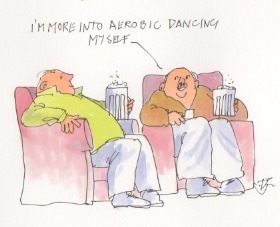SEDENTARY BEHAVIOUR Part 1
What’s that?
Sedentary behaviour is any time spent primarily sitting or lying down and which involves expenditure of 1.5 metabolic equivalents (METs) or less. Examples are sitting, watching television, playing video games, and using a computer. Too much sitting must be seen as distinct from too little exercise. Just sitting about is dangerous in its own right even if you do take enough exercise.
How much sitting about do we do?
The 2008 Health Survey for England (HSE) survey reported that around 40% of adults spend 6 hours or more per day sitting down at weekends and slightly fewer on weekdays. A more recent assessment of sedentary behaviour comes from the HSE 2012. The self-reported average daily sitting time was 5.4 hours for men and 5.1 hours for women at weekends and 4.9 hours for men and 4.7 for women on weekdays. In each case about 3 hours per day was spent watching TV. The trend was for more sedentary behaviour among the young (16 to 24) with an average sedentary time of 7 hours/day, and the old (70 to 79) at 9 hours /day, the so-called U shaped curve.
The figures from the US are similar. A national study of nearly 6,000 adults in 2015/6 found that 26% sat for more than eight hours per day, with 45% not getting any moderate or vigorous exercise and about 11% sitting for more than eight hours and being physically inactive. Things may have got worse for young people with the huge growth in smartphone use. .
For young people the influence of the Covid Lockdown has produced some unexpected effects. In a study of 400 US college students, those participants who were not highly active before the pandemic actually increased physical activity after the closure of campus and the transition to remote learning. The participants who were highly active before the pandemic, however, experienced a decrease in overall physical activity. Weird!
Older people were also considered by the SITLESS study (nice title) which examined the sedentary behaviour of 1360 community dwelling elderly adults average age 75. It reported that 79% of waking time was spent sitting, 18.6% in light activity and just 2.6% in moderately vigorous activity. Watching TV and reading accounted for 47% of waking time.
There are clear occupational variations in sedentary behaviour with office workers, as expected, spending more sitting time than blue collar workers, though office workers do partly compensate for this risk by taking more leisure time moderate and vigorous exercise than manual workers.
The harmful effects of too much sitting
Too much sitting does not automatically mean too little exercise but there is a tendency. For instance among university students there is a linear relationship between time spent on the phone and decreasing levels of physical fitness . Even for adults who meet the minimal public health recommendations on physical activity on most days each week, there are still deleterious metabolic consequences of the 9 to 10 hours of sitting that can occupy their remaining “non-exercise” time. A new physical activity population known as ‘active couch potatoes’ has emerged – those who apparently take the recommended amount of exercise but spend excess time just sitting around.
The risk of death increases for any sedentary time greater than 7 hours/day but can be offset by exercising. One study of office workers found that those who exercised for one hour per day had a premature mortality of 6.8% compared with those who did less than 5 minutes/day whose premature mortality was 9.9%. Both total sedentary time per day and length of sedentary bouts are predictors of premature death and the combination of the two triples the risk of premature mortality. This has even received a label – “the sedentary death syndrome”!
The news is not all bad. Though regular exercise does not eliminate the perils induced by too much TV watching, it does reduce the impact. A meta-analysis involving more than 1 million souls found that you needed to watch television for more than five hours /day to reduce the benefits of a regular exercise habit. About an hour’s exercise a day offsets the ill effects of sitting at work for eight hours.
PS
I have received this from my friend James:
“I listened to the final two episodes of the BBC Happiness Half Hour during a walk yesterday and I thought this one – No 9 out the 10 – would be right up your street if you don’t already know it, and you might even want to recommend it. BBC Radio Bristol – The Happiness Half Hour, 9. Healthy body = happy mind. Or is it vice versa?
I do recommend it – the important bits are in the later parts of No 9 and earlier parts of No 10.
Subscribe to the blog
Categories
- Accelerometer
- Alzheimer's disease
- Blood pressure
- BMI
- Cancer
- Complications
- Coronary disease
- Cycling
- Dementia
- Diabetes
- Events
- Evidence
- Exercise promotion
- Frailty
- Healthspan
- Hearty News
- Hypertension
- Ill effects
- Infections
- Lifespan
- Lipids
- Lung disease
- Mental health
- Mental health
- Muscles
- Obesity
- Osteoporosis
- Oxygen uptake
- Parkinson's Disease
- Physical activity
- Physical fitness
- Pregnancy
- Running
- Sedentary behaviour
- Strength training
- Stroke
- Uncategorized
- Walking



Thanks, Hugh, it’s great to make a small contribution to your wonderful blog.
Thanks for the great content sir .i will also share with my friends & once again Thanks a Lot.
The World’s Trusted Online Pharmacy Stores for Australia,USA, UK, Canada and EU .Buy Generic Medicine We offer wide range of Generic Product with quality.
duoble-force-100mg
duralast-dapoxetine
edalis-10mg
edalis-20mg
edegra-100mg
efil-10mg